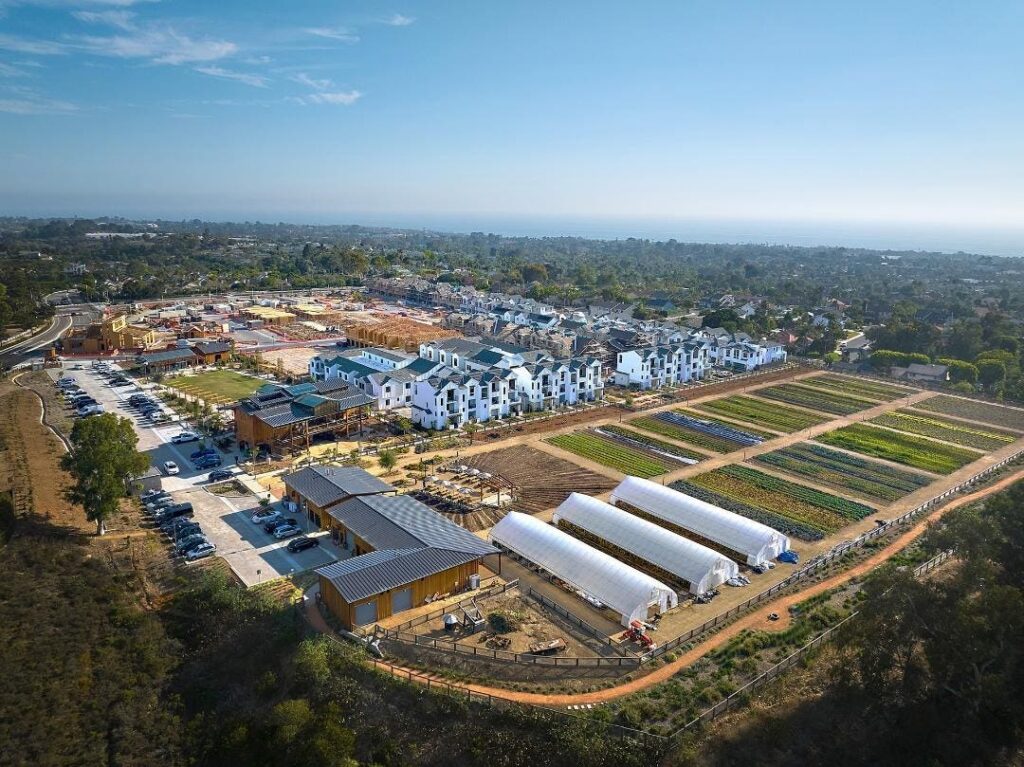According to the WELL Building Institute, WELL for Residential “is the first and only holistic, third-party verified certification program to exclusively address health and well-being in all residence types, including single-family homes and units in multifamily buildings.”
As is the case with all WELL Building Standards, this lines up well with Earth Day goals of using environmental sustainability to promote health and well-being.
A number of unique projects, currently numbering 20 to 25 worldwide, are among the first to pilot the WELL for Residential certification. Here are three such projects.
Fox Point Farms. From Shea Homes and Nolen Communities, this is San Diego’s first “agrihood.” Situated in a dense beachside enclave, its layout features urban and suburban spaces arrayed around farmland. The agrihood’s nine-acre commercial portion was unveiled last summer. It includes a three-acre regenerative farm, zero-waste farm-to-table restaurants, organic brewery and coffee roaster, produce market, wellness facilities and farm classes. The dozen acres of residences under construction offer 250 housing units extending from single-family houses to affordable housing. Community amenities include walking trails, a recreation center and edible gardens.
“What sets Fox Point Farms apart is its layered approach, combining biophilia with regenerative agriculture, a strong emphasis on social cohesion and a commitment to the WELL for Residential standard,” says Paul Barnes, president of Shea Homes San Diego. “It’s a community designed for modern living while honoring time-tested agrarian principles. In that sense, it’s not just a biophilic community, it’s a system that supports both human and environmental well-being in a way that’s rare if not totally unique.”
Jubilee. By Johnson Development, this is a 4,200 single-family home community in Hockley, Texas, near Houston, that emphasizes positivity and calls itself “the joyful neighborhood.” It is the largest single-family development pursuing WELL for residential. Nine builders are marketing homes in Jubilee, with their common theme being helping residents manage stress and negativity while also promoting overall health through home design, community amenities and activities. Peppered through Jubilee are “wellness zones” emphasizing connection, exploration, reflection and inspiration, designed to relax, energize, inspire or ground those who visit.
CM1. This single-family custom home in Miami, Fla. from developer Caplow Manzano focuses on wellness, durability and resilience. Among the initial companies joining the pilot and receiving WELL residence certification, Caplow Manzano served up crucial input during the pilot phase. Designed to provide increased resilience in the face of extreme weather, CM1 is elevated 10 feet above grade. The design’s emphasis on health impacted every aspect of the home’s development, including materials selection, building maintenance, access to natural light and mold-resistant construction.
People first
The evolution of residential market best practices and sustainable design has helped put health and well-being front and center in home buyers’ consciousness, says Kelsey Mullen, a LEED-AP architect and sustainability expert who is supporting Fox Point Farms through the WELL for Residential certification. “We are finding health is the evolution of sustainability in residential construction,” he says. “WELL for Residential was influenced by the WELL building standard that previously focused on commercial properties only, bringing people-first design standards into the home environment.”
He added that crucial health aspects affecting physical and mental health are emphasized in the standard. They include air and water quality, access to daylight and nature, biophilic design, connections within neighborhoods, safety and security.
Concludes Mullen: “The development of WELL for residential included residential experts and input from industry stakeholders to deliver a program that not only pushes the envelope of health best practice but also includes a certification process that can integrate and scale into the residential business model.”
Read the full article here

